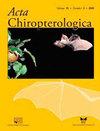南非风能对蝙蝠影响的知识现状
IF 0.7
4区 生物学
Q4 ZOOLOGY
引用次数: 0
摘要
减缓气候变化的过渡需要可再生能源的快速和全球扩散,但这不应危及实现同样重要的生物多样性目标的需要。风能是全球蝙蝠死亡的主要原因,但对非洲蝙蝠的影响知之甚少。我在南非研究了这些影响,以提高人们对风能对非洲蝙蝠影响的认识。我回顾了发表在科学期刊和技术报告上的59项研究的数据,这些报告是关于风力涡轮机中蝙蝠死亡的运行监测。蝙蝠死亡事件发生在南非所有运行中的风能设施。以埃及Tadarida aegyptica居多,其次为Neoromicia capensis和Miniopterus natalensis。大多数死亡是发生在2月至4月之间的非迁徙物种,尽管蝙蝠在所有月份都被杀死。不同风能设施的蝙蝠死亡率在观测死亡率/年、估计死亡率/年和估计死亡率/兆瓦/年方面存在差异,但这些差异不能用大范围的植被模式来解释。2011年至2020年蝙蝠死亡总数估计为12601只。平均病死率为2.8只/MW/年。我估计,在2013年到2050年之间,南非风能设施可能会杀死至少996974只蝙蝠。我的研究结果首次估计了风能对南非和非洲大陆蝙蝠的潜在影响。本文章由计算机程序翻译,如有差异,请以英文原文为准。
Current State of Knowledge of Wind Energy Impacts on Bats in South Africa
The transition to mitigate climate change necessitates a rapid and global diffusion of renewable energy but this should not jeopardise the need to meet similarly important targets for biodiversity. Wind energy is a leading cause of bat mortality globally, yet little is known about the impacts to bats in Africa. I studied these impacts in South Africa to enhance knowledge on wind energy impacts on African bats. I reviewed data from 59 studies published in scientific journals and technical reports of operational monitoring of bat fatalities at wind turbines. Bat fatalities occurred at all operating wind energy facilities in South Africa. Tadarida aegyptiaca accounted for the majority of carcasses, followed by Neoromicia capensis and Miniopterus natalensis. The majority of fatalities were of non-migratory species and occurred between February and April although bats were killed in all months. Bat fatality differed between wind energy facilities in terms of observed fatality/year, estimated fatality/year and estimated fatality/MW/year but these differences could not be explained by broad scale vegetation patterns. Total estimated bat fatality between 2011 and 2020 was 12,601 bats. Mean fatality/MW/year was 2.8 bats. I estimate that between 2013 and 2050, a minimum of 996,974 bats may be killed at South African wind energy facilities. My results present the first estimates of the scale of potential wind energy impacts to bats in South Africa and the African continent.
求助全文
通过发布文献求助,成功后即可免费获取论文全文。
去求助
来源期刊

Acta Chiropterologica
生物-动物学
CiteScore
2.50
自引率
20.00%
发文量
42
审稿时长
>12 weeks
期刊介绍:
Acta Chiropterologica, published by the Museum and Institute of Zoology at the Polish Academy of Sciences, is devoted solely to the study and discussion of bats.
 求助内容:
求助内容: 应助结果提醒方式:
应助结果提醒方式:


